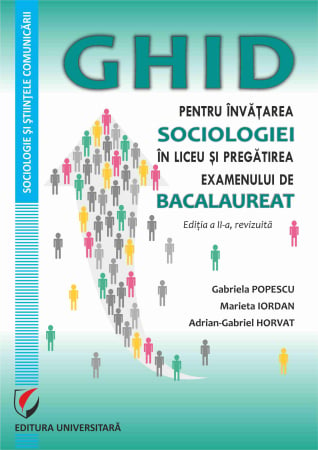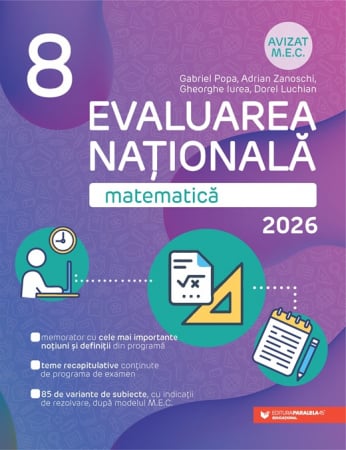Manuscript proposals: [email protected] / 0745 204 115 //// Tracking orders Individuals / Sales: 0745 200 357 / Orders Legal entities: 0721 722 783
Publisher: Editura Universitară
Author: Valeriu Sofronie
Edition: II
Pages: 320
Publisher year: 2024
ISBN: 978-606-28-1760-2
DOI: https://doi.org/10.5682/9786062817602
Product Code:
9786062817602
Do you need help?
0745 200 357
- Description
- Download (1)
- Authors
- Content
- More details
- Reviews (0)
This paper is addressed both to candidates for the Baccalaureate exam, as well as to those from the faculties who have the exam sample in the discipline "Logic, communication and argumentation".
The proposed subjects comply with the requirements of the 2024 Baccalaureate program, as well as the model of exam subjects developed by the Ministry of Education. Also, the manner in which the subjects in the second part of the work were conceived faithfully follows the requirements of the grid-type forms, present in the subjects of the simulations, the proposed models and the subjects of admission to the profile studies of the last years.
The variants of subjects proposed for the Baccalaureate are accompanied by scales of solving, extended and restricted, as well as models for writing the paper. The grid subjects for college admission are also accompanied by solutions, but also by expositions of the ways of solving (thinking) the requirements.
The author has over two and a half decades of experience in developing subject variants for the promotion of Baccalaureate exams and college admission. We want this experience, through the way it has been capitalized in this guide, to offer real support in learning and success in exams.
The proposed subjects comply with the requirements of the 2024 Baccalaureate program, as well as the model of exam subjects developed by the Ministry of Education. Also, the manner in which the subjects in the second part of the work were conceived faithfully follows the requirements of the grid-type forms, present in the subjects of the simulations, the proposed models and the subjects of admission to the profile studies of the last years.
The variants of subjects proposed for the Baccalaureate are accompanied by scales of solving, extended and restricted, as well as models for writing the paper. The grid subjects for college admission are also accompanied by solutions, but also by expositions of the ways of solving (thinking) the requirements.
The author has over two and a half decades of experience in developing subject variants for the promotion of Baccalaureate exams and college admission. We want this experience, through the way it has been capitalized in this guide, to offer real support in learning and success in exams.
-
Logic for Baccalaureate and college admission. Complete guide. Second edition
Download
VALERIU SOFRONIE
Why this guide? / (5)
What should we expect? (Subject structure) / (7)
Argued solution of the subjects from the baccalaureate model (1) / (58)
Argued solution of the subjects from the baccalaureate model (2) / (79)
Tests developed according to the baccalaureate model - 2024. Resolution of the proposed subjects / (97)
Test no. 1 / (98)
Test no. 1. Extended scale of self-evaluation and model for developing the answer / (103)
Test no. 2 / (118)
Test no. 2. Extended scale of self-evaluation and model for developing the answer / (123)
Test no. 3 / (138)
Test no. 3. Self-evaluation scale / (143)
Test no. 4 / (152)
Test no. 4. Self-evaluation scale / (157)
Test no. 5 / (167)
Test no. 5. Self-evaluation scale / (172)
Test no. 6 / (182)
Test no. 6. Self-evaluation scale / (187)
Test no. 7 / (196)
Test no. 7. Self-evaluation scale / (201)
Test no. 8 / (211)
Test no. 8. Self-evaluation scale / (216)
Test no. 9 / (226)
Test no. 9. Self-evaluation scale / (231)
Test no. 10 / (241)
Test no. 10. Self-evaluation scale / (246)
Difficulties in applying the Venn diagram method to demonstrate the validity of syllogistic modes with valid universal premises and particular conclusion / (255)
Addenda / (265)
Detailed analysis and solution of the subject of logic - Bucharest Faculty of Law / (278)
College Test (1) / (298)
College Test (2) / (309)
Bibliographic sources / (317)
What should we expect? (Subject structure) / (7)
Argued solution of the subjects from the baccalaureate model (1) / (58)
Argued solution of the subjects from the baccalaureate model (2) / (79)
Tests developed according to the baccalaureate model - 2024. Resolution of the proposed subjects / (97)
Test no. 1 / (98)
Test no. 1. Extended scale of self-evaluation and model for developing the answer / (103)
Test no. 2 / (118)
Test no. 2. Extended scale of self-evaluation and model for developing the answer / (123)
Test no. 3 / (138)
Test no. 3. Self-evaluation scale / (143)
Test no. 4 / (152)
Test no. 4. Self-evaluation scale / (157)
Test no. 5 / (167)
Test no. 5. Self-evaluation scale / (172)
Test no. 6 / (182)
Test no. 6. Self-evaluation scale / (187)
Test no. 7 / (196)
Test no. 7. Self-evaluation scale / (201)
Test no. 8 / (211)
Test no. 8. Self-evaluation scale / (216)
Test no. 9 / (226)
Test no. 9. Self-evaluation scale / (231)
Test no. 10 / (241)
Test no. 10. Self-evaluation scale / (246)
Difficulties in applying the Venn diagram method to demonstrate the validity of syllogistic modes with valid universal premises and particular conclusion / (255)
Addenda / (265)
Detailed analysis and solution of the subject of logic - Bucharest Faculty of Law / (278)
College Test (1) / (298)
College Test (2) / (309)
Bibliographic sources / (317)
From the beginning, I conceived the future Baccalaureate or Faculty candidate as a traveler in an unknown country. In the absence of a guide to lead him, giving him the necessary explanations, putting at hand travel information, maps, plans, guidelines, etc., he will definitely experience a failure, which will turn the desired joy of the expedition into - an ordeal. Territories for travel are not only the geographical areas of the world, but also the vast fields of knowledge. Mathematics, physics, literature, etc. They are, individually, vast areas, unknown to the outside eye. That is why, when we step into such territory, it is useful to ask for the guidance of a "local". In addition, if most of the subjects in the class are studied for years, sometimes for the entire duration of the student's activity, logic has the disadvantage of being in the school curriculum for only one year. Moreover, the one who chose it as the subject of the exam should be looking for additional support points. Our conclusion is that Logic is a discipline that requires a specialized guide. Responding to such a need, meeting it, I designed this learning guide. The guide, of whatever kind, is a practical enterprise. On this "practical" dimension, I would like to add some ideas.
It is a well-known fact that, in order to support the learning of logic, a series of "guides" appeared on the "market" of books intended for this purpose, which, from our perspective, do not fully justify their intention. The student wants not only to have something to solve, but also to be shown "how" to do it. The student wants to be guided, and many of the logic works addressed to him fail to do this. They suffer either from an excess of theory, or from an almost exclusive burden of tests, rarely offering even brief solutions. The "guides" in the first way, at best explain the theory in the manual. But they do not actually help the candidate, but only double his learning effort. At the end of them, he finds himself as timid, helpless, as he was at the beginning, not knowing HOW to do what he is asked to do. The second kind of guide, the guide with many tests, but with indications of laconic solutions, such as those found in the evaluation scales for the subjects of the national exams, does not help much either, not having a guiding-corrective role. If he made a mistake, the candidate does not understand where he made a mistake, and if he answered correctly, he does not know why it was correct.
I tried to overcome both deficiencies in this guide. I designed it on the principle: I have to start from what is required, to what I have to do to solve what is required. For this reason, I resorted to theory only out of practical needs, leading it each time to precise ends: solving the test. The paper is divided into two distinct parts: the Baccalaureate Section and the Faculty Section. After the prior presentation of the type of admission requirements, each section is built on two plans: a) step-by-step solution of the subjects given in previous years; b) the development of test sets, closely following the models for the development of subjects intended for both the Baccalaureate Exam and the one for admission to the faculty. The rest of the information can be found in detail in the work.
Author
It is a well-known fact that, in order to support the learning of logic, a series of "guides" appeared on the "market" of books intended for this purpose, which, from our perspective, do not fully justify their intention. The student wants not only to have something to solve, but also to be shown "how" to do it. The student wants to be guided, and many of the logic works addressed to him fail to do this. They suffer either from an excess of theory, or from an almost exclusive burden of tests, rarely offering even brief solutions. The "guides" in the first way, at best explain the theory in the manual. But they do not actually help the candidate, but only double his learning effort. At the end of them, he finds himself as timid, helpless, as he was at the beginning, not knowing HOW to do what he is asked to do. The second kind of guide, the guide with many tests, but with indications of laconic solutions, such as those found in the evaluation scales for the subjects of the national exams, does not help much either, not having a guiding-corrective role. If he made a mistake, the candidate does not understand where he made a mistake, and if he answered correctly, he does not know why it was correct.
I tried to overcome both deficiencies in this guide. I designed it on the principle: I have to start from what is required, to what I have to do to solve what is required. For this reason, I resorted to theory only out of practical needs, leading it each time to precise ends: solving the test. The paper is divided into two distinct parts: the Baccalaureate Section and the Faculty Section. After the prior presentation of the type of admission requirements, each section is built on two plans: a) step-by-step solution of the subjects given in previous years; b) the development of test sets, closely following the models for the development of subjects intended for both the Baccalaureate Exam and the one for admission to the faculty. The rest of the information can be found in detail in the work.
Author
If you want to express your opinion about this product you can add a review.
write a review

6359.png)
![Logic for Baccalaureate and college admission. Complete guide. Second edition [1] Logic for Baccalaureate and college admission. Complete guide. Second edition [1]](https://gomagcdn.ro/domains/editurauniversitara.ro/files/product/large/logica-pentru-bacalaureat-si-admitere-la-facultate-ghid-complet-editia-a-ii-a-356881.jpg)














